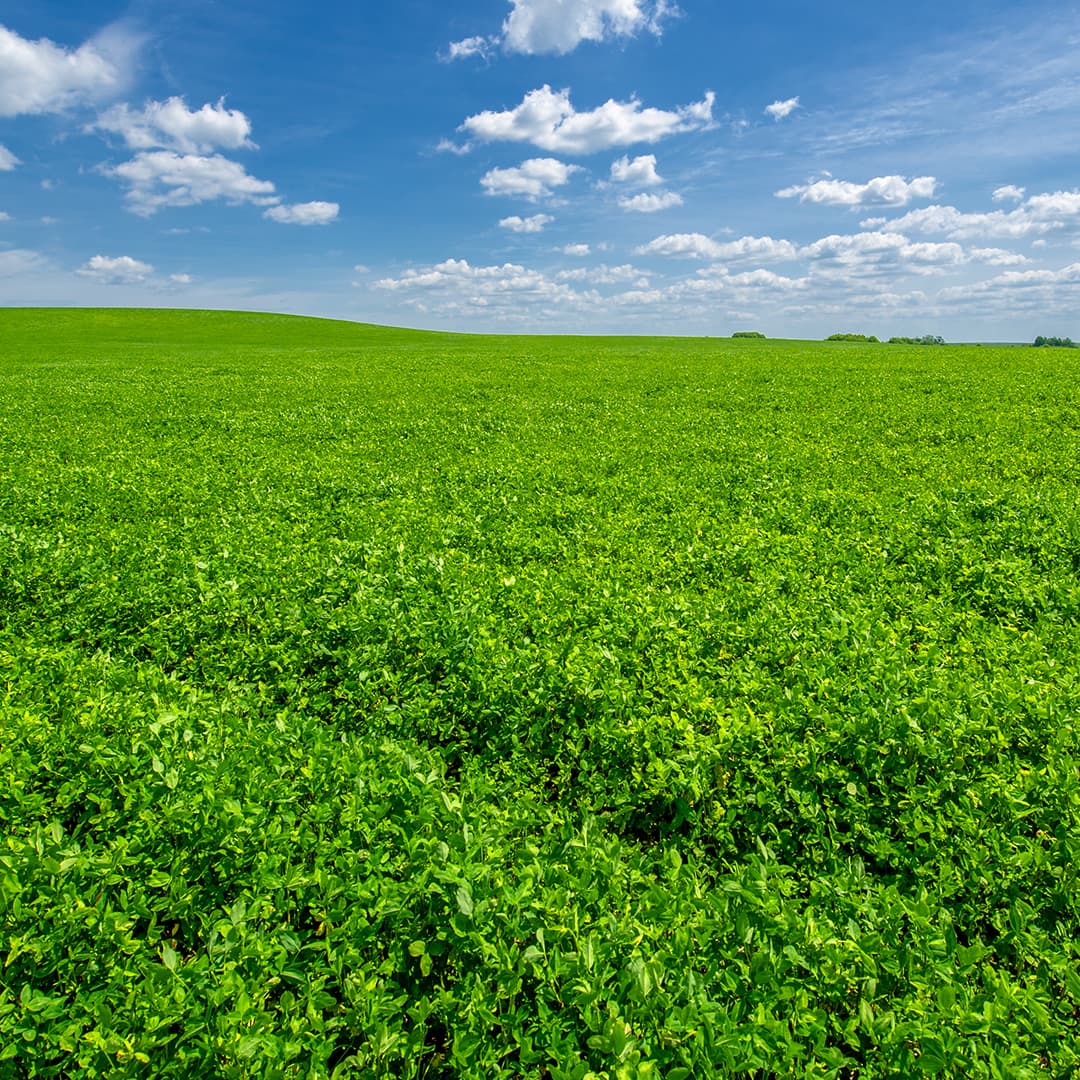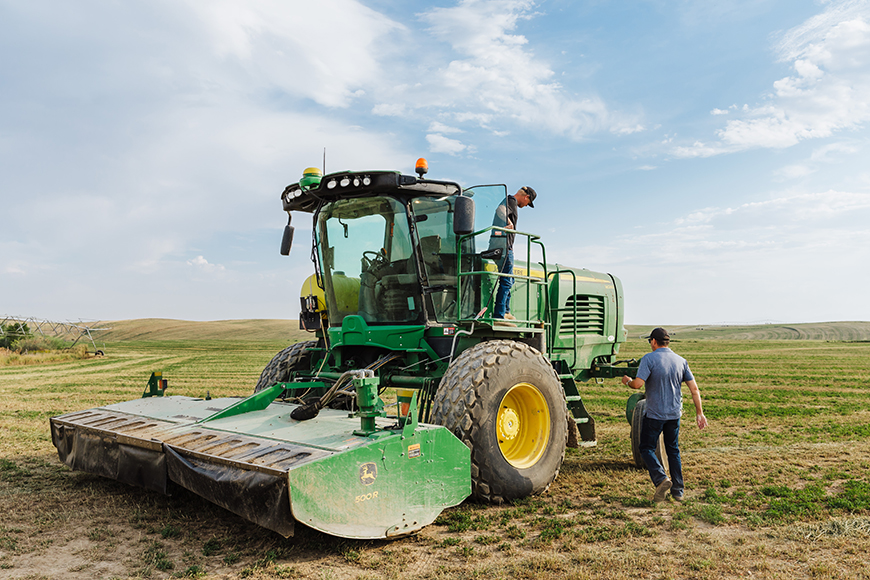How often have you harvested a beautiful field of alfalfa or a newly established stand of a high-quality variety of alfalfa, only to find out later that the lab test results were only average? Rather than assuming you received inaccurate lab test results or did not obtain the promised benefits from the high-quality alfalfa variety, perhaps the lower than expected lab test was the result of leaf loss.
Leaf loss is one of the major factors negatively impacting harvested alfalfa forage quality. Leaf percentage accounts for 71% of variation in forage quality, because leaves have a Relative Forage Quality (RFQ) of approximately 550 while stems have an RFQ of only 70 to 80 (Undersander, 2017 NAFA News). Therefore, growers must know the percent leaves in their alfalfa to better manage growing, harvesting and evaluating their alfalfa. While there are many forage quality measurements we can perform on alfalfa, until now there has been no reliable rapid test to predict the amount of leaves in a sample of alfalfa that is typically dried, ground and analyzed in a lab. Researchers at Forage Genetics International (FGI) decided to develop such a test.
LEAF Prediction Equation Development
During the summer of 2019, 160 samples of standing alfalfa plants were collected from FGI research plots at West Salem, WI, Nampa, ID, and Davis, CA. Across all locations, a total of 43 varieties of alfalfa were harvested similarly using a variety of cutting schedules (28, 33, 35 or 38 days) across a range of cuttings (first, second and third).
Plants were sent to West Salem where they were dried at a temperature less than 60 degrees C, followed by hand separation and weighing of leaf and stem fractions. After recording the weights, the two fractions were recombined and ground over a 1 mm screen. From there, they were forwarded to the FGI In Vitro Digestibility Lab at Gray Summit, MO, for Calibrate High Quality (HQ) Forage Analysis testing. This included NIR and “wet” lab analysis for dry matter (DM), ash, crude protein, neutral detergent fiber (NDF) and 28 hr. in vitro NDF digestibility (NDFd28). These values were then compared with the percent leaf fraction in each sample in a stepwise regression analysis approach to develop an equation to predict percent leaves from the best-fit 2, 3 or 4 component models.
The following year (2020) 40 new whole plant samples were collected from the Davis, CA and West Salem, WI research locations using similar methods to the previous year and run through the same protocol to be used as validation of the accuracy of the % leaf prediction equation developed in 2019.
Prediction Equation Accuracy
The findings from the 2020 validation set of 40 samples showed that the standard error of the prediction was extremely low (2.86 percentage units of leaves) across a wide range of 35 to 64% leaves in the samples. This indicates that the leaf prediction equation can be “off” by an average of only 2.86 percentage units of leaves on a given sample. These 40 samples were added to the original 160 samples and a new prediction equation, LEAF (Leaves Enhance Alfalfa Forage), was developed that predicts percent leaves in alfalfa from NDF, protein and NDFd28 measured in the sample. This equation explained 84% of the variation in leaf percentage in these samples (see Figure 1). The samples in the calibration dataset represented a wide range in quality, ranging in NDF from 21 to 48%, crude protein from 16-31%, and NDFd28 from 37 to 60%. The measured leaf percentage ranged from 35 to 70%, with an average of 52% (std. dev. of 8.6%; Figure 2 left chart).
What Is a Typical Leaf Percentage in Alfalfa?
The LEAF equation was used to predict the leaf percentage of 360 samples of alfalfa that were collected during 2019 from across the US and analyzed at the FGI Gray Summit In Vitro Digestibility Lab. The samples represented a wide range in quality, ranging in NDF from 16 to 67%, crude protein from 8-30%, and NDFd28 from 34 to 62%. The predicted leaf percentage ranged from 10-77%, with an average of 48% (std. dev. of 12.6%; Figure 2 right chart). Averaged across both sets of data in Figure 2, the average leaf percentage in alfalfa was approximately 50%, with a standard deviation close to 10%. Therefore, two-thirds of the sample population had a leaf percentage between 40 and 60%, which could be considered a “typical” range.
With this in mind, we went a step further and compared the relationship between the Relative Forage Quality (RFQ) and LEAF percent in the 360 samples from 2019. As you can see in Figure 3, leaves influence RFQ in a positive, increasing manner with a very high relationship. The equation from this relationship was then used to predict the RFQ at various levels of LEAF percent in alfalfa around the average of 50% noted from the two datasets (Figure 3).
One takeaway from this graph is the increasing return in RFQ value that can be gained from increasing retention of leaves during growing and harvesting of alfalfa. The other discovery is that over the range between 40 and 60% leaves, each 1 percentage unit increase in leaves yielded an increase of 4.6 units of RFQ. What this indicates is that it takes only a little more than 2 percent additional leaves to increase the RFQ of a bale of alfalfa by 10 units. This emphasizes the importance that leaves play in the quality of alfalfa forage and why it is worthwhile spending the extra effort to not lose leaves from the field to the mouth of a ruminant animal.
What Causes Leaf Loss in Alfalfa?
The following is just a brief listing of factors affecting leaf loss in alfalfa:
-
Fungal and other alfalfa diseases
-
Mower/conditioner type and settings
-
Rake type, excessive raking or raking when the alfalfa is less than 40% moisture
-
Baler type and settings
-
Grinding or excessive mixing of hay before feeding
How Should I Use the LEAF Percent Value?
First, use the LEAF percent value to identify and measure a major source of quality variation in alfalfa. This way growers and producers can have a more objective conversation when discussing alfalfa sample quality test results. If the protein and NDF digestibility are lower than expected, and the NDF is higher than expected, check for leaf loss as the cause. If the LEAF percentage is less than 45%, evaluate areas for alfalfa management improvement. Consider options such as fungicide application, using more disease or pest resistant alfalfa varieties and don’t forget the many harvest management improvements that can be put into action.
How Can I Get This Test?
The LEAF test has not been validated with alfalfa/grass mixed forages and is currently intended only for pure stands of alfalfa. Furthermore, the LEAF test has only been validated against nutrient inputs from the Calibrate High Quality Forage Analysis Test. Lab variation in these nutrient input measurements from other forage tests could likely affect the accuracy of the percent leaf predictions if they were used as replacement values in the LEAF test. Currently, the LEAF test is available as part of the Calibrate High Quality Forage Analysis results from SureTech® Laboratories. However, the goal is to make the LEAF test available to all labs providing the Calibrate High Quality Forage Analysis test, now that a year-long field evaluation of the LEAF test has been completed. For more information, please contact BDHodne@foragegenetics.com.
©2021 Forage Genetics International, LLC. LEAF is a trademark of Forage Genetics International, LLC. SureTech is a trademark of WinField United.



